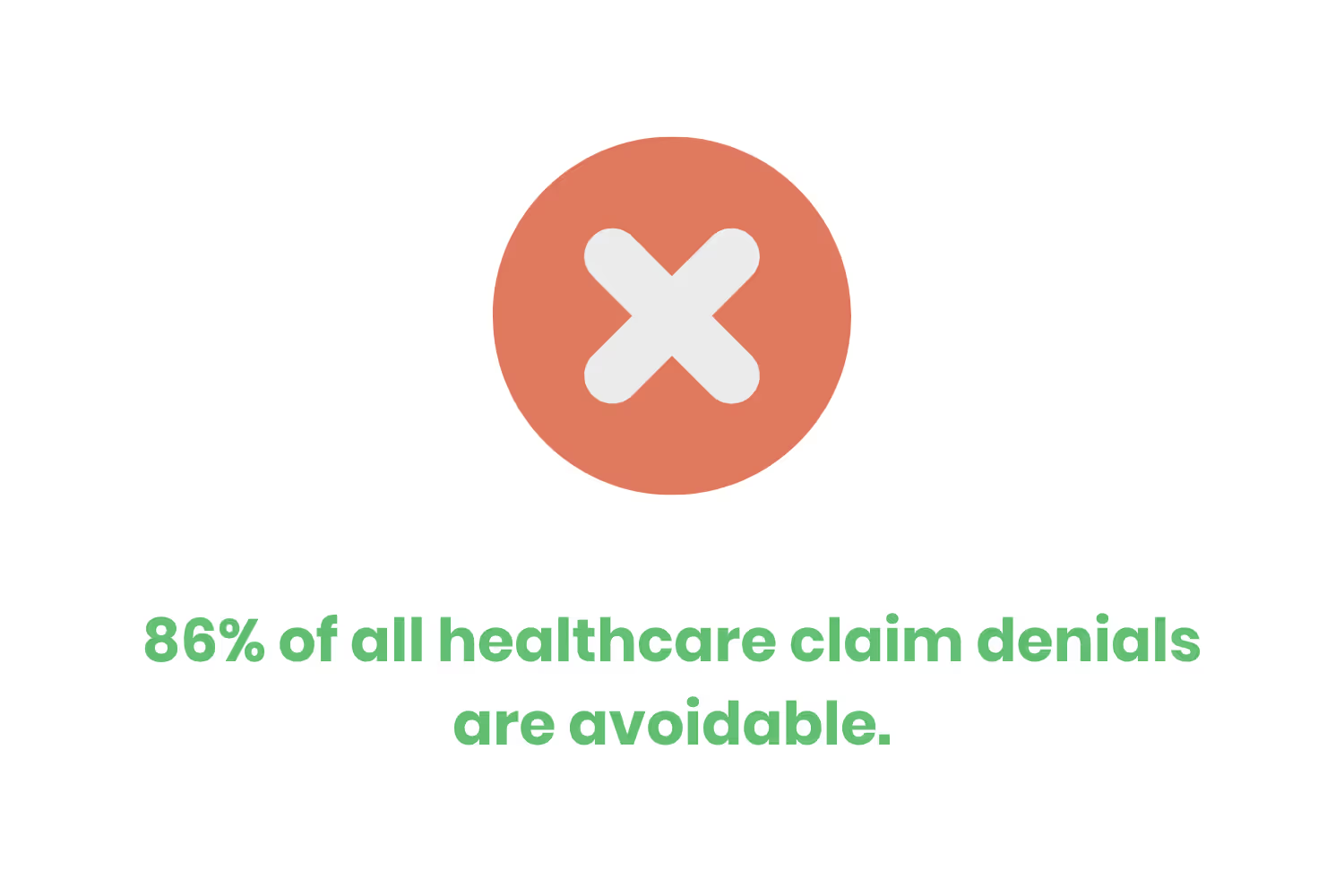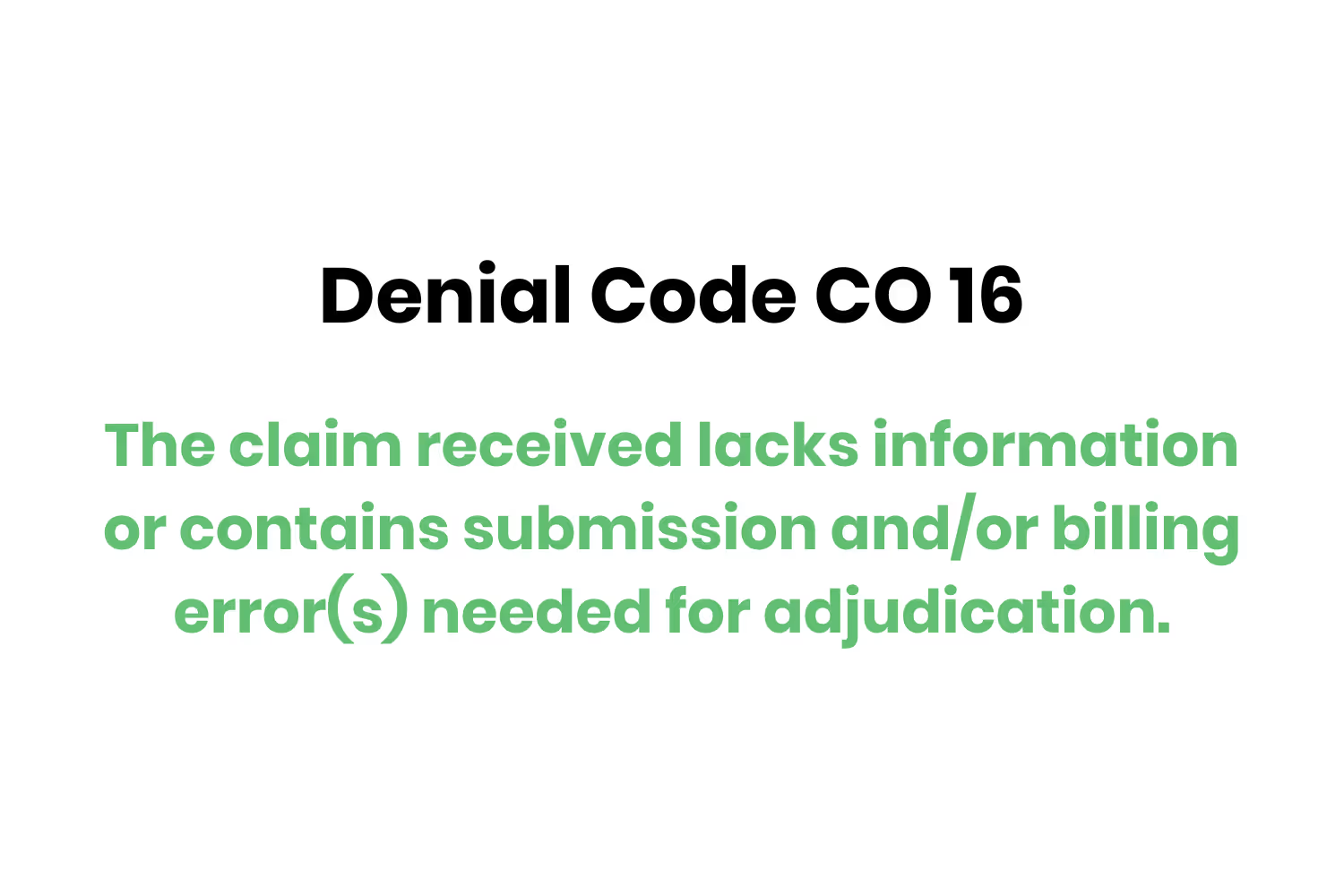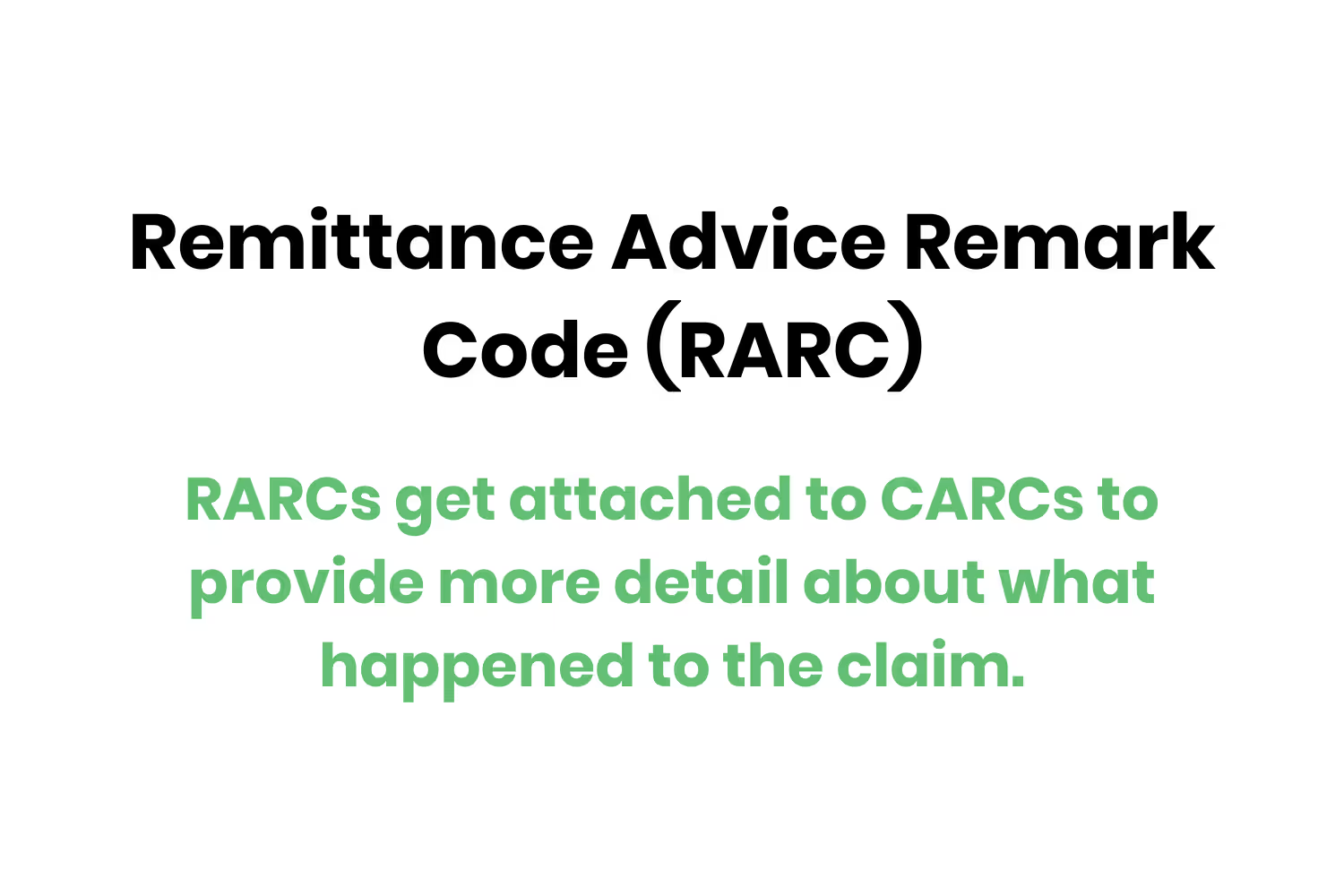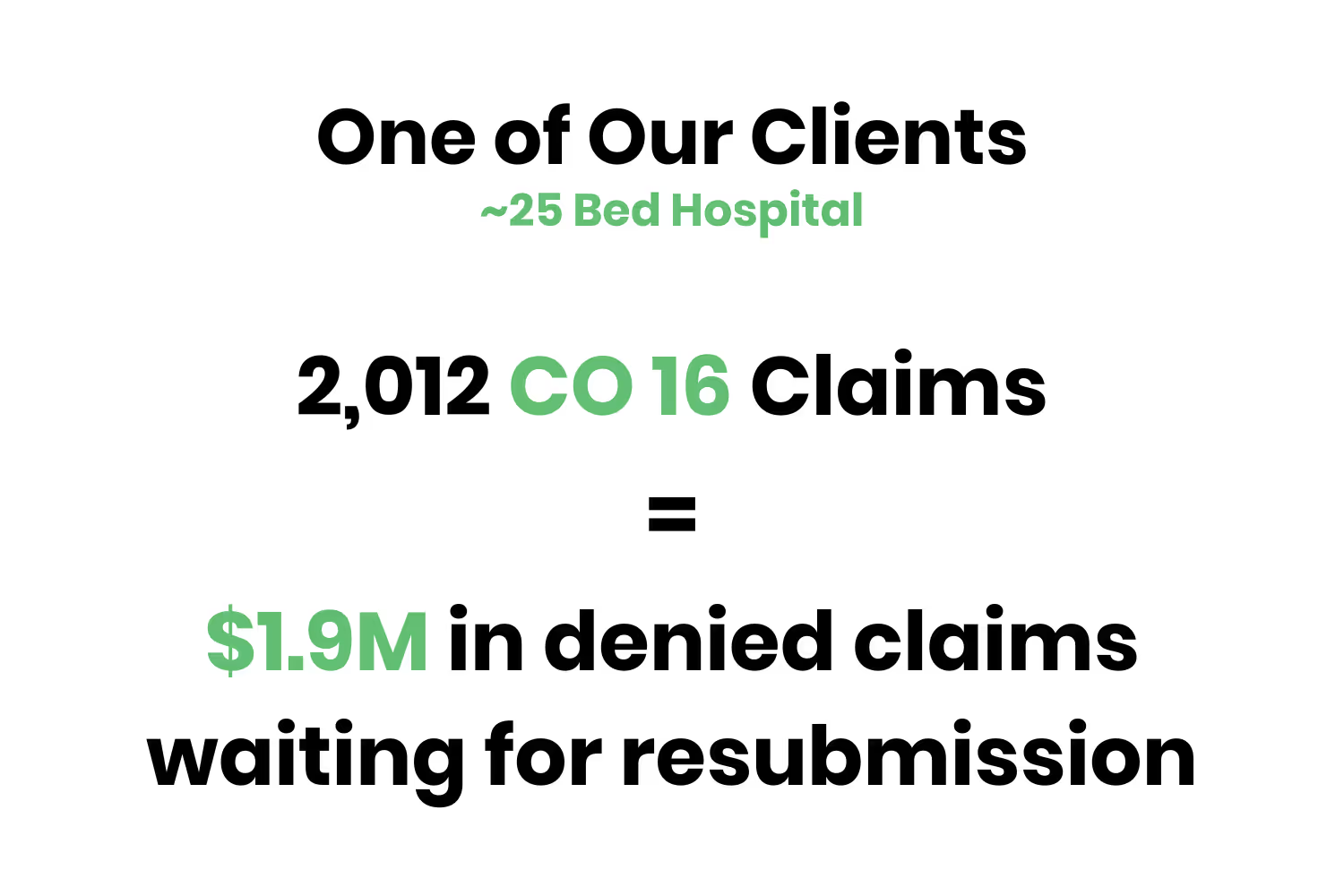Denial Code CO16: Common RARCs and More
One of the most common denial codes is CO-16. In this blog post, I’ll provide you with everything you need to know about what CO16 is, how to avoid it and how to overturn it.

86% of all healthcare claim denials are avoidable.
The biggest takeaway from that statistic? A lot of the revenue loss that healthcare organizations experience is preventable.
Why is this the case? I mean, if you told any business that 86% of the revenue that they’re losing on an annual basis could be re-obtained they would instantly implement the workflows necessary to do so.
Of course, the true answer to that question is that healthcare claim submission isn’t cut and dry.

There are a lot of moving parts associated with it…and it oftentimes happens to be an afterthought for many healthcare organizations. After all, healthcare is in the “business” of treating patients…not catering to the claim submission requirements set forth by insurance providers.
There’s also the possibility that insurance providers intentionally make it difficult for healthcare organizations because they view their claim submission guardrails as necessary for documentation purposes.
Either way, the fact of the matter is that healthcare organizations can’t afford to forego the revenue associated with their avoidable claim denials. But where do they start?
Insurance organizations tell you why they denied a specific claim by using a specific code. Since Etactics is a clearinghouse with over 20 years of experience…it’s safe to say that we’ve seen a pattern. Healthcare organizations struggle with certain denial codes more so than others.
One of those common denial codes is CO16. In this blog post, I’ll provide you with everything you need to know about what CO16 is, how to avoid it and how to overturn it.
What is denial code CO16?
Denial code CO16 is a “Contractual Obligation” claim adjustment reason code (CARC).
What does that sentence mean? Basically, it’s a code that signifies a denial and it falls within the grouping of the same that’s based on the contract and as per the fee schedule amount. CO is a large denial category with over 200 individual codes within it.
Insurance organizations tend to place denials within this category when…
- A joint payer/payee regulatory requirement results in an adjustment that the member isn’t responsible for
- The provider’s charge exceeds the reasonable and customary amount for which the patient is responsible
Providers have the sole financial responsibility when a CO denial comes back to them. Naturally, that also means that the patient or beneficiary cannot receive any of the financial responsibility.

That’s great, but what does this particular denial code mean?
Denial code CO16 means that the claim received lacks information or contains submission and/or billing error(s) needed for adjudication. In other words, the submitted claim doesn’t have what the insurance company wants on it, or something is wrong.
I know what you’re thinking, “That’s super generic.” Yes, CO16 has such a catch-all definition that technically every denial should come back containing it, right?
Well, CO16 can’t exist by itself. Claims denied with this status come back with a remittance advice remark code (RARC) attached to them.
Common CO16 RARCs
RARCs get attached to CARCs to provide more detail about what happened to the claim.
After all, it wouldn’t be very helpful to your billing team if every denial moving forward came back as JUST a CO16…it’s too generic of definition.
Although RARCs exist to provide more helpful information, there are almost 1,200 of them listed on X12’s website. So, memorizing each one isn’t an option.
The Council for Affordable Quality Healthcare (CAQH) has attempted to limit the number of code combinations through its “CORE” rules. It provides specific business cases for when to use a CO16, and which remark code to pair with it.
This is where our tenured experience as a clearinghouse comes in handy. Let’s take a look at some of the most common RARCs that we see attached to CO16.
P.S. The worst scenario for this type of denial happens when a payer doesn’t send it back with a RARC attached. Although rare, this does sometimes happen.

M12
M12 is a specific common RARC that we often see paired up with CO16. What does it mean?
M12 signifies that any diagnostic tests performed by a physician must indicate whether the claim includes purchased services.
In other words, the claim doesn’t contain the proper information regarding a purchase.
M60
Another common RARC that we see getting paired up with CO16 is M60. Luckily, this one is pretty straightforward.
M60 means that the submitted claim is missing a certificate of medical necessity (CMN).
In most cases, you’ll find that the issue with M60 denials is that the CMN isn’t linked correctly to the claim within the provider’s software. That happens for the majority of M60 denials but isn’t always the case.
While this could be an obvious omission on the first claim for oxygen or enteral patient, it might not show up as much if they came over from another supplier and you don't know their CMN/DIF status beforehand.
N264 and N575
Do you remember when I mentioned in the section about CO16 that it could signify something is wrong? That statement alluded to this section.
The truth is that CO16 doesn’t always mean that missing information was the problem. It could also mean that there is invalid information within the claim. Luckily, that’s why RARC’s N264 and N575 exist.
- N264: Missing/incomplete/invalid ordering provider name.
- N575: Mismatch between the submitted ordering/referring provider name and records.
The implementation of the PECOS enrollment requirement in 2014 caused DMEPOS providers to see a large increase in CO16 denials when ordering physicians who weren’t enrolled. The N264/N575 remark codes came into play during this scenario.
M124
An M124 remark code signifies that the claim is missing identification of whether the patient owns the equipment that requires the part or supply.
Let’s say that a new fee-for-service Medicare patient didn’t have their base equipment billed through Medicare, and the provider is attempting to bill supplies or accessories. In those instances, Medicare requires that box 19 on the CMS-1500 form or the NTE field for electronic claims contains…
- HCPCS code of the base equipment
- Notation that the beneficiary owns the equipment
- The date the patient received the equipment
Can I ignore denial code CO16?
The answer to this question from me is always going to be that you should never ignore a denial code, regardless of the specific code.
Although they’re frustrating and the world would arguably be a better place if insurance organizations weren’t so rigid, the truth is that denial codes help your organization run better.
When a denial comes back to you with a specific code, that’s insight as to what’s not working well within your organization. Is your front-end staff running into hiccups during the initial stages of an appointment? Or, are your billers not double-checking their work before submitting your claims?

I’m getting too general. Let’s shift back to denial code CO16. What’s the actual cost associated with not managing your CO16 denials?
One of our 25-bed hospital clients received 2,012 claims with CO16 from 1/1/2022 - 9/1/2022. These denials contained 74 unique combinations of RARCs attached to them and were worth $1.9 million.
Since CO16 has such a generic definition AND there are well over 1,000 RARC codes, it makes sense as to why it’s one of the most common types of denials.
I can’t imagine many organizations can ignore almost $2 million worth of denied claims. That’s a lot of money to write off.
What's the best way to manage denial code CO16?
Overturning CO16 denials is rather straightforward (definitely more so than CO 4). Add the incorrect information and resubmit it to the payer.
But the reality is that overturning CO16 denials isn’t what’s difficult about it. The hardest part about this type is managing its volume.
You saw the statistic from earlier that mentioned one of our clients. They had over 2,000 CO16 claims with over 70 unique RARCs. So, they not only had to locate each of those denials… they also had to figure out what each of the RARCs meant.

In other words, the best way to manage claims that come back with denial code CO16 is by having a system that automatically categorizes denials according to their RARC.
Luckily, they were our clients.
Without a system that helps your denial ecosystem, you’re going to have to deal with a mountain of work that you cannot sift through.
Conclusion
There are two absolutes when it comes to medical claim submission. First, you’re going to receive denials. Second, a lot of those denials will contain denial code CO16.
But overturning this type of denial isn't hard. The difficult aspect is managing all of them according to their attached RARC.
That's why it’s so important to choose the right clearinghouse vendor who also places a high focus on denial management. Not managing your denials at all will leave you with tons of revenue on the table!
Emphasize your product's unique features or benefits to differentiate it from competitors
In nec dictum adipiscing pharetra enim etiam scelerisque dolor purus ipsum egestas cursus vulputate arcu egestas ut eu sed mollis consectetur mattis pharetra curabitur et maecenas in mattis fames consectetur ipsum quis risus mauris aliquam ornare nisl purus at ipsum nulla accumsan consectetur vestibulum suspendisse aliquam condimentum scelerisque lacinia pellentesque vestibulum condimentum turpis ligula pharetra dictum sapien facilisis sapien at sagittis et cursus congue.
- Pharetra curabitur et maecenas in mattis fames consectetur ipsum quis risus.
- Justo urna nisi auctor consequat consectetur dolor lectus blandit.
- Eget egestas volutpat lacinia vestibulum vitae mattis hendrerit.
- Ornare elit odio tellus orci bibendum dictum id sem congue enim amet diam.
Incorporate statistics or specific numbers to highlight the effectiveness or popularity of your offering
Convallis pellentesque ullamcorper sapien sed tristique fermentum proin amet quam tincidunt feugiat vitae neque quisque odio ut pellentesque ac mauris eget lectus. Pretium arcu turpis lacus sapien sit at eu sapien duis magna nunc nibh nam non ut nibh ultrices ultrices elementum egestas enim nisl sed cursus pellentesque sit dignissim enim euismod sit et convallis sed pelis viverra quam at nisl sit pharetra enim nisl nec vestibulum posuere in volutpat sed blandit neque risus.

Use time-sensitive language to encourage immediate action, such as "Limited Time Offer
Feugiat vitae neque quisque odio ut pellentesque ac mauris eget lectus. Pretium arcu turpis lacus sapien sit at eu sapien duis magna nunc nibh nam non ut nibh ultrices ultrices elementum egestas enim nisl sed cursus pellentesque sit dignissim enim euismod sit et convallis sed pelis viverra quam at nisl sit pharetra enim nisl nec vestibulum posuere in volutpat sed blandit neque risus.
- Pharetra curabitur et maecenas in mattis fames consectetur ipsum quis risus.
- Justo urna nisi auctor consequat consectetur dolor lectus blandit.
- Eget egestas volutpat lacinia vestibulum vitae mattis hendrerit.
- Ornare elit odio tellus orci bibendum dictum id sem congue enim amet diam.
Address customer pain points directly by showing how your product solves their problems
Feugiat vitae neque quisque odio ut pellentesque ac mauris eget lectus. Pretium arcu turpis lacus sapien sit at eu sapien duis magna nunc nibh nam non ut nibh ultrices ultrices elementum egestas enim nisl sed cursus pellentesque sit dignissim enim euismod sit et convallis sed pelis viverra quam at nisl sit pharetra enim nisl nec vestibulum posuere in volutpat sed blandit neque risus.
Vel etiam vel amet aenean eget in habitasse nunc duis tellus sem turpis risus aliquam ac volutpat tellus eu faucibus ullamcorper.
Tailor titles to your ideal customer segment using phrases like "Designed for Busy Professionals
Sed pretium id nibh id sit felis vitae volutpat volutpat adipiscing at sodales neque lectus mi phasellus commodo at elit suspendisse ornare faucibus lectus purus viverra in nec aliquet commodo et sed sed nisi tempor mi pellentesque arcu viverra pretium duis enim vulputate dignissim etiam ultrices vitae neque urna proin nibh diam turpis augue lacus.




